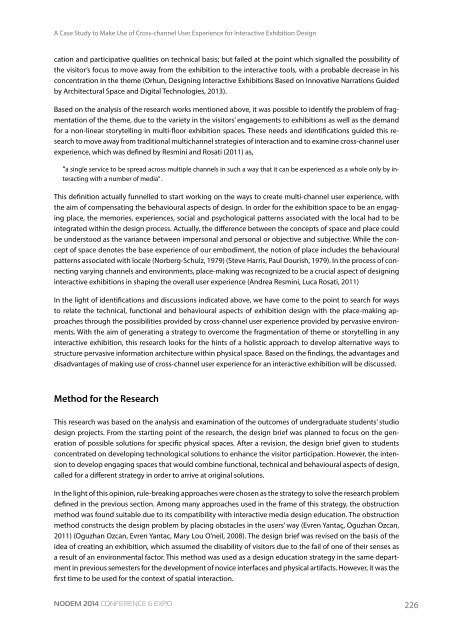NODEM 2014 Proceedings
NODEM 2014 Proceedings
NODEM 2014 Proceedings
You also want an ePaper? Increase the reach of your titles
YUMPU automatically turns print PDFs into web optimized ePapers that Google loves.
A Case Study to Make Use of Cross-channel User Experience for Interactive Exhibition Design<br />
cation and participative qualities on technical basis; but failed at the point which signalled the possibility of<br />
the visitor’s focus to move away from the exhibition to the interactive tools, with a probable decrease in his<br />
concentration in the theme (Orhun, Designing Interactive Exhibitions Based on Innovative Narrations Guided<br />
by Architectural Space and Digital Technologies, 2013).<br />
Based on the analysis of the research works mentioned above, it was possible to identify the problem of fragmentation<br />
of the theme, due to the variety in the visitors’ engagements to exhibitions as well as the demand<br />
for a non-linear storytelling in multi-floor exhibition spaces. These needs and identifications guided this research<br />
to move away from traditional multichannel strategies of interaction and to examine cross-channel user<br />
experience, which was defined by Resmini and Rosati (2011) as,<br />
“a single service to be spread across multiple channels in such a way that it can be experienced as a whole only by interacting<br />
with a number of media” .<br />
This definition actually funnelled to start working on the ways to create multi-channel user experience, with<br />
the aim of compensating the behavioural aspects of design. In order for the exhibition space to be an engaging<br />
place, the memories, experiences, social and psychological patterns associated with the local had to be<br />
integrated within the design process. Actually, the difference between the concepts of space and place could<br />
be understood as the variance between impersonal and personal or objective and subjective. While the concept<br />
of space denotes the base experience of our embodiment, the notion of place includes the behavioural<br />
patterns associated with locale (Norberg-Schulz, 1979) (Steve Harris, Paul Dourish, 1979). In the process of connecting<br />
varying channels and environments, place-making was recognized to be a crucial aspect of designing<br />
interactive exhibitions in shaping the overall user experience (Andrea Resmini, Luca Rosati, 2011)<br />
In the light of identifications and discussions indicated above, we have come to the point to search for ways<br />
to relate the technical, functional and behavioural aspects of exhibition design with the place-making approaches<br />
through the possibilities provided by cross-channel user experience provided by pervasive environments.<br />
With the aim of generating a strategy to overcome the fragmentation of theme or storytelling in any<br />
interactive exhibition, this research looks for the hints of a holistic approach to develop alternative ways to<br />
structure pervasive information architecture within physical space. Based on the findings, the advantages and<br />
disadvantages of making use of cross-channel user experience for an interactive exhibition will be discussed.<br />
Method for the Research<br />
This research was based on the analysis and examination of the outcomes of undergraduate students’ studio<br />
design projects. From the starting point of the research, the design brief was planned to focus on the generation<br />
of possible solutions for specific physical spaces. After a revision, the design brief given to students<br />
concentrated on developing technological solutions to enhance the visitor participation. However, the intension<br />
to develop engaging spaces that would combine functional, technical and behavioural aspects of design,<br />
called for a different strategy in order to arrive at original solutions.<br />
In the light of this opinion, rule-breaking approaches were chosen as the strategy to solve the research problem<br />
defined in the previous section. Among many approaches used in the frame of this strategy, the obstruction<br />
method was found suitable due to its compatibility with interactive media design education. The obstruction<br />
method constructs the design problem by placing obstacles in the users’ way (Evren Yantaç, Oguzhan Ozcan,<br />
2011) (Oguzhan Ozcan, Evren Yantac, Mary Lou O’neil, 2008). The design brief was revised on the basis of the<br />
idea of creating an exhibition, which assumed the disability of visitors due to the fail of one of their senses as<br />
a result of an environmental factor. This method was used as a design education strategy in the same department<br />
in previous semesters for the development of novice interfaces and physical artifacts. However, it was the<br />
first time to be used for the context of spatial interaction.<br />
<strong>NODEM</strong> <strong>2014</strong> Conference & Expo<br />
226


